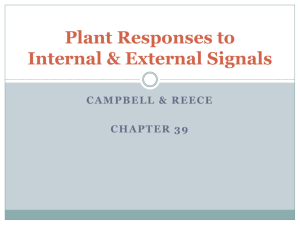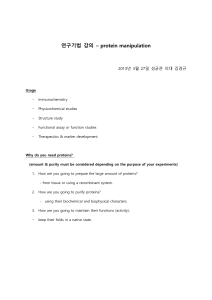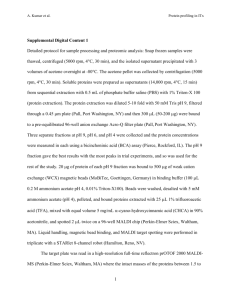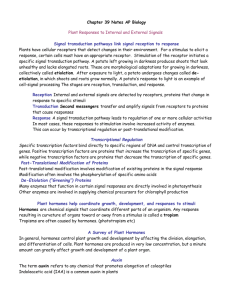39-PLANT RESPONSES TO INTERNAL AND - mr-youssef-mci
advertisement
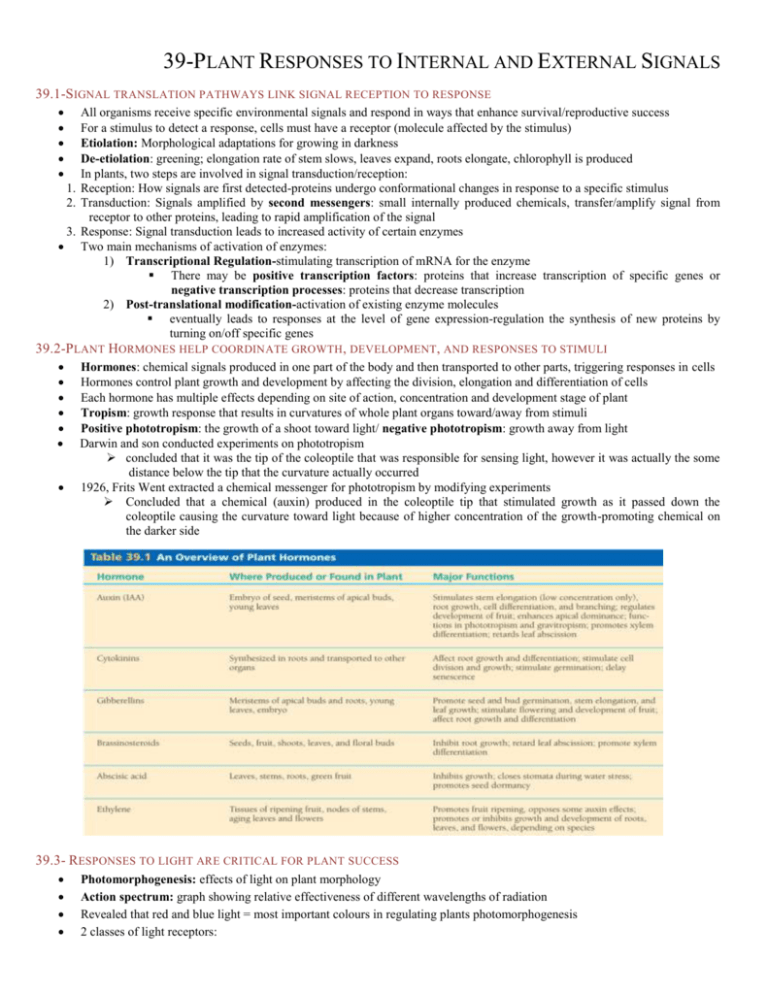
39-PLANT RESPONSES TO INTERNAL AND EXTERNAL SIGNALS 39.1-S IGNAL TRANSLATION PATHWAYS LINK SIGNAL RECEPTION TO RESPONSE All organisms receive specific environmental signals and respond in ways that enhance survival/reproductive success For a stimulus to detect a response, cells must have a receptor (molecule affected by the stimulus) Etiolation: Morphological adaptations for growing in darkness De-etiolation: greening; elongation rate of stem slows, leaves expand, roots elongate, chlorophyll is produced In plants, two steps are involved in signal transduction/reception: 1. Reception: How signals are first detected-proteins undergo conformational changes in response to a specific stimulus 2. Transduction: Signals amplified by second messengers: small internally produced chemicals, transfer/amplify signal from receptor to other proteins, leading to rapid amplification of the signal 3. Response: Signal transduction leads to increased activity of certain enzymes Two main mechanisms of activation of enzymes: 1) Transcriptional Regulation-stimulating transcription of mRNA for the enzyme There may be positive transcription factors: proteins that increase transcription of specific genes or negative transcription processes: proteins that decrease transcription 2) Post-translational modification-activation of existing enzyme molecules eventually leads to responses at the level of gene expression-regulation the synthesis of new proteins by turning on/off specific genes 39.2-P LANT HORMONES HELP COORDINATE GROWTH, DEVELOPMENT, AND RESPONSES TO STIMULI Hormones: chemical signals produced in one part of the body and then transported to other parts, triggering responses in cells Hormones control plant growth and development by affecting the division, elongation and differentiation of cells Each hormone has multiple effects depending on site of action, concentration and development stage of plant Tropism: growth response that results in curvatures of whole plant organs toward/away from stimuli Positive phototropism: the growth of a shoot toward light/ negative phototropism: growth away from light Darwin and son conducted experiments on phototropism concluded that it was the tip of the coleoptile that was responsible for sensing light, however it was actually the some distance below the tip that the curvature actually occurred 1926, Frits Went extracted a chemical messenger for phototropism by modifying experiments Concluded that a chemical (auxin) produced in the coleoptile tip that stimulated growth as it passed down the coleoptile causing the curvature toward light because of higher concentration of the growth-promoting chemical on the darker side 39.3- RESPONSES TO LIGHT ARE CRITICAL FOR PLANT SUCCESS Photomorphogenesis: effects of light on plant morphology Action spectrum: graph showing relative effectiveness of different wavelengths of radiation Revealed that red and blue light = most important colours in regulating plants photomorphogenesis 2 classes of light receptors: 1. Blue-light Photoreceptors: Initiates phototropism (opening of stomata) and slowing of hypocotyls elongation (when seedling breaks ground) 2. Phytochromes as Photoreceptors Seed germination: The last flash of light determined the seeds response-effects of red and far-red light are reversible Pr exposed to red light- change to Pfr, stimulating germination. Pfr exposed to far-red light, change to Pr, inhibiting germination Shade avoidance: Provides info about quality of light, helps plant detect light/track of days/seasons B IOLOGICAL C LOCKS AND C IRCADIAN R HYTHMS Circadian rhythms: cycles with a frequency of 24 hours with no pacing of environment variable Molecular “gears” for clock are endogenous (internal)-not based on environmental cycles Photoperiod: relative lengths of night and day used for plants to detect the time of year Photoperiodism: physiological response to photoperiod (flowering) Short-day plant: only requires a short period of light to flower (Chrysanthemums, poinsettias) Long-day plants: only flower when the light period is longer than a certain number of hours (Spinach-more than 14 hours) Day-neutral plants: unaffected by photoperiod, flowers when mature (regardless of day length) Ex. Tomatoes,dandelions C RITICAL N IGHT L ENGTH In 1940, it was found that flowering and other responses were not due to day length, but night length Long day plants grown on long nights will continue to flower even if interrupted by periods of light Vernilization: pre-treatment of plants to cold temperatures to induce flowering: 39.4- P LANTS RESPOND TO A WIDE VARIETY OF STIMULI OTHER THAN LIGHT 1. 2. 3. Gravity: Gravitropism: responses to gravity-Ensures that root grows into soil (pulls them down) and shoots grow towards sunlight Statoliths: specialized plastids containing dense starch grains to lower portions of cells Mechanical Stimuli Thigmomorphogenesis: changes in form from mechanical perturbation Touch specialists: plants with acute responsiveness to mechanical stimuli Thigmotropism: directional growth in response to touch Action potential: fast electrical impulse signals sent through plant (slower than nerve impulses in humans) Environmental Stresses Abiotic: non-living/ Biotic: living Drought: Water deficiency, stomata close, slowing transpiration: release of abscisic acid, acting on guard cell membranes Flooding: Oxygen deprivation stimulates production of ethylene, causing cells to undergo apoptosis Salt stress: Lowers water potential of soil solution-causes water deficit in plants (halophiles: salt-tolerant plants ) Heat Stress: heat denatures enzymes/ metabolism (heat-shock proteins: helping proteins fold into functional shapes) Cold Stress: loss in fluidity-lipids locked into crystalline structures, proteins in membranes cannot function 39.5-P LANTS DEFEND THEMSELVES AGAINST HERBIVORES AND PATHOGENS Herbivores: Herbivory: stress from plant eating animals Jasmonic Acid: important molecule in plant defence, activates genes that attract other species to prey on predator Pathogens: Virulent: pathogens a plant has little specific defence against Avirulent: strains of pathogens that only mildly harm but do not kill host plant R-protein receptor in plants triggers resistance by binding to correct corresponding Avr protein If plant lacks R gene, cant counteract pathogen’s Avr gene= death for cell Elicitors: molecules inducing host defence, stimulate production of antimicrobial compounds: phytoalexins Oligosaccharins: cellulose fragments released by cell wall damage, major class of elicitors Infection activates PR proteins (pathogenesis-related proteins), attacking molecules in cell walls of bacterium Hypersensitive response: avirulent pathogen, enhanced production of phytoalexins and PR Proteins. Pathogen sealed off at site, and all cells die Systemic Acquired Resistance (SAR): non-specific, provides protection against diversity of pathogens






